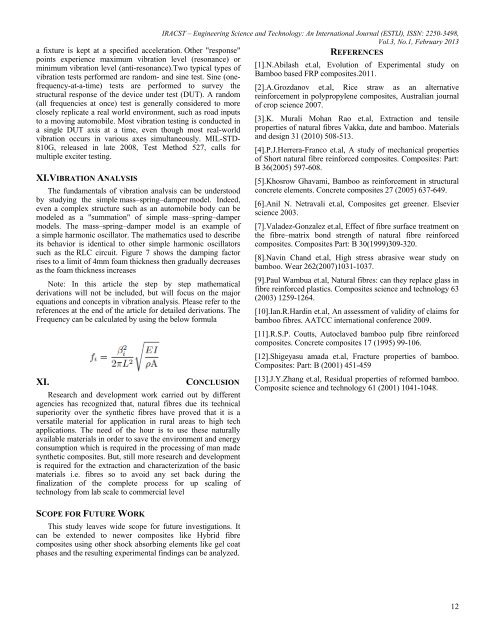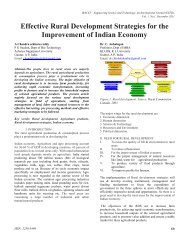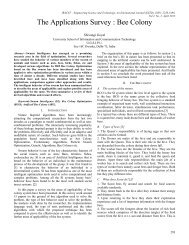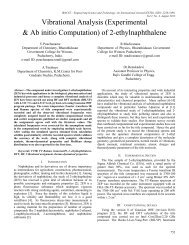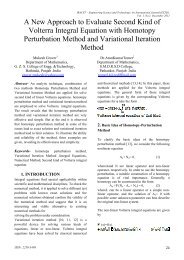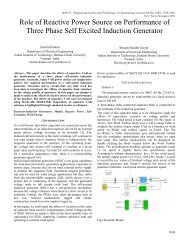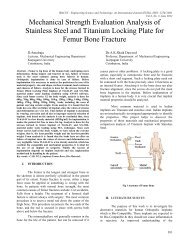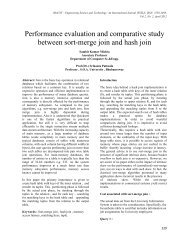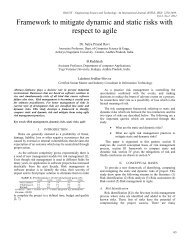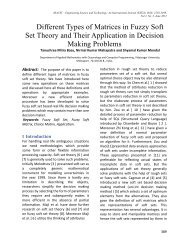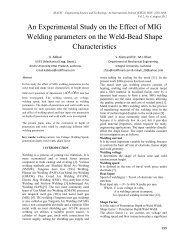testing the vibrational behaviour of jute fiber based sandwich ...
testing the vibrational behaviour of jute fiber based sandwich ...
testing the vibrational behaviour of jute fiber based sandwich ...
You also want an ePaper? Increase the reach of your titles
YUMPU automatically turns print PDFs into web optimized ePapers that Google loves.
a fixture is kept at a specified acceleration. O<strong>the</strong>r "response"points experience maximum vibration level (resonance) orminimum vibration level (anti-resonance).Two typical types <strong>of</strong>vibration tests performed are random- and sine test. Sine (onefrequency-at-a-time)tests are performed to survey <strong>the</strong>structural response <strong>of</strong> <strong>the</strong> device under test (DUT). A random(all frequencies at once) test is generally considered to moreclosely replicate a real world environment, such as road inputsto a moving automobile. Most vibration <strong>testing</strong> is conducted ina single DUT axis at a time, even though most real-worldvibration occurs in various axes simultaneously. MIL-STD-810G, released in late 2008, Test Method 527, calls formultiple exciter <strong>testing</strong>.XI.VIBRATION ANALYSISThe fundamentals <strong>of</strong> vibration analysis can be understoodby studying <strong>the</strong> simple mass–spring–damper model. Indeed,even a complex structure such as an automobile body can bemodeled as a "summation" <strong>of</strong> simple mass–spring–dampermodels. The mass–spring–damper model is an example <strong>of</strong>a simple harmonic oscillator. The ma<strong>the</strong>matics used to describeits behavior is identical to o<strong>the</strong>r simple harmonic oscillatorssuch as <strong>the</strong> RLC circuit. Figure 7 shows <strong>the</strong> damping factorrises to a limit <strong>of</strong> 4mm foam thickness <strong>the</strong>n gradually decreasesas <strong>the</strong> foam thickness increasesNote: In this article <strong>the</strong> step by step ma<strong>the</strong>maticalderivations will not be included, but will focus on <strong>the</strong> majorequations and concepts in vibration analysis. Please refer to <strong>the</strong>references at <strong>the</strong> end <strong>of</strong> <strong>the</strong> article for detailed derivations. TheFrequency can be calculated by using <strong>the</strong> below formulaXI.CONCLUSIONResearch and development work carried out by differentagencies has recognized that, natural fibres due its technicalsuperiority over <strong>the</strong> syn<strong>the</strong>tic fibres have proved that it is aversatile material for application in rural areas to high techapplications. The need <strong>of</strong> <strong>the</strong> hour is to use <strong>the</strong>se naturallyavailable materials in order to save <strong>the</strong> environment and energyconsumption which is required in <strong>the</strong> processing <strong>of</strong> man madesyn<strong>the</strong>tic composites. But, still more research and developmentis required for <strong>the</strong> extraction and characterization <strong>of</strong> <strong>the</strong> basicmaterials i.e. fibres so to avoid any set back during <strong>the</strong>finalization <strong>of</strong> <strong>the</strong> complete process for up scaling <strong>of</strong>technology from lab scale to commercial levelIRACST – Engineering Science and Technology: An International Journal (ESTIJ), ISSN: 2250-3498,Vol.3, No.1, February 2013REFERENCES[1].N.Abilash et.al, Evolution <strong>of</strong> Experimental study onBamboo <strong>based</strong> FRP composites.2011.[2].A.Grozdanov et.al, Rice straw as an alternativereinforcement in polypropylene composites, Australian journal<strong>of</strong> crop science 2007.[3].K. Murali Mohan Rao et.al, Extraction and tensileproperties <strong>of</strong> natural fibres Vakka, date and bamboo. Materialsand design 31 (2010) 508-513.[4].P.J.Herrera-Franco et.al, A study <strong>of</strong> mechanical properties<strong>of</strong> Short natural fibre reinforced composites. Composites: Part:B 36(2005) 597-608.[5].Khosrow Ghavami, Bamboo as reinforcement in structuralconcrete elements. Concrete composites 27 (2005) 637-649.[6].Anil N. Netravali et.al, Composites get greener. Elsevierscience 2003.[7].Valadez-Gonzalez et.al, Effect <strong>of</strong> fibre surface treatment on<strong>the</strong> fibre–matrix bond strength <strong>of</strong> natural fibre reinforcedcomposites. Composites Part: B 30(1999)309-320.[8].Navin Chand et.al, High stress abrasive wear study onbamboo. Wear 262(2007)1031-1037.[9].Paul Wambua et.al, Natural fibres: can <strong>the</strong>y replace glass infibre reinforced plastics. Composites science and technology 63(2003) 1259-1264.[10].Ian.R.Hardin et.al, An assessment <strong>of</strong> validity <strong>of</strong> claims forbamboo fibres. AATCC international conference 2009.[11].R.S.P. Coutts, Autoclaved bamboo pulp fibre reinforcedcomposites. Concrete composites 17 (1995) 99-106.[12].Shigeyasu amada et.al, Fracture properties <strong>of</strong> bamboo.Composites: Part: B (2001) 451-459[13].J.Y.Zhang et.al, Residual properties <strong>of</strong> reformed bamboo.Composite science and technology 61 (2001) 1041-1048.SCOPE FOR FUTURE WORKThis study leaves wide scope for future investigations. Itcan be extended to newer composites like Hybrid fibrecomposites using o<strong>the</strong>r shock absorbing elements like gel coatphases and <strong>the</strong> resulting experimental findings can be analyzed.12


